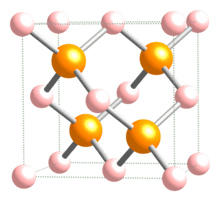Boron phosphide
Boron phosphide (BP) (also referred to as boron monophosphide, to distinguish it from boron subphosphide, B12P2) is a chemical compound of boron and phosphorus. It is a semiconductor.[3]
 | |
| Identifiers | |
|---|---|
3D model (JSmol) |
|
| ECHA InfoCard | 100.039.616 |
PubChem CID |
|
CompTox Dashboard (EPA) |
|
| |
| Properties | |
| BP | |
| Molar mass | 41.7855 g/mol |
| Appearance | maroon powder |
| Density | 2.90 g/cm3 |
| Melting point | 1,100 °C (2,010 °F; 1,370 K) (decomposes) |
| Band gap | 2.1 eV (indirect, 300 K)[1] |
| Thermal conductivity | 4.6 W/(cm·K) (300 K) [2] |
Refractive index (nD) |
3.0 (0.63 µm)[1] |
| Structure | |
| Zinc blende | |
| F43m | |
| Tetrahedral | |
Except where otherwise noted, data are given for materials in their standard state (at 25 °C [77 °F], 100 kPa). | |
| Infobox references | |
History
Crystals of boron phosphide were synthesized by Henri Moissan as early as in 1891.[4]
Appearance
Pure BP is almost transparent, n-type crystals are orange-red whereas p-type ones are dark red.[5]
Chemical properties
BP is not attacked by acids or boiling aqueous alkali water solutions. It is only attacked by molten alkalis.[5]
Physical properties
Some properties of BP are listed below:[1][5]
- lattice constant 0.45383 nm
- coefficient of thermal expansion 3.65×10−6 /°C (400 K)
- heat capacity CP ~ 0.8 J/(g·K) (300 K)
- Debye temperature = 985 K
- Bulk modulus 152 GPa
- relatively high microhardness of 32 GPa (100 g load).
- electron and hole mobilities of a few hundred cm2/(V·s) (up to 500 for holes at 300 K)
- room temperature thermal conductivity of 460 W/mK was reported for high quality single crystals
gollark: rule .
gollark: <SQUARE BRACKETS DELETED>
gollark: [DATA EXPUNGED]
gollark: Anyway, <@!356107472269869058>, do you actually believe (in) Pascal's wager?
gollark: Well, the policy doesn't supersede stuff like physical law yet.
References
- Madelung, O. (2004). Semiconductors: Data Handbook. Birkhäuser. pp. 84–86. ISBN 978-3-540-40488-0.
- Kang, J.; Wu, H.; Hu, Y. (2017). "Thermal Properties and Phonon Spectral Characterization of Synthetic Boron Phosphide for High Thermal Conductivity Applications". Nano Letters. 17: 7507. doi:10.1021/acs.nanolett.7b03437. PMID 29115845.
- Popper, P.; Ingles, T. A. (1957). "Boron Phosphide, a III–V Compound of Zinc-Blende Structure". Nature. 179: 1075. doi:10.1038/1791075a0.
- Moissan, H. (1891). "Préparation et Propriétés des Phosphures de Bore". Comptes Rendus. 113: 726–729.
- Berger, L. I. (1996). Semiconductor Materials. CRC Press. p. 116. ISBN 978-0-8493-8912-2.
ISBN 0849389127.
Further reading
- King, R. B., ed. (1999). Boron Chemistry at the Millennium. Elsevier Science & Technology. ISBN 0-444-72006-5.
- US patent 6831304, Takashi, U., "P-N Junction Type Boron Phosphide-Based Semiconductor Light-Emitting Device and Production Method thereof", issued 2004-12-14, assigned to Showa Denko
- Stone, B.; Hill, D. (1960). "Semiconducting Properties of Cubic Boron Phosphide". Physical Review Letters. 4 (6): 282–284. Bibcode:1960PhRvL...4..282S. doi:10.1103/PhysRevLett.4.282.
This article is issued from Wikipedia. The text is licensed under Creative Commons - Attribution - Sharealike. Additional terms may apply for the media files.